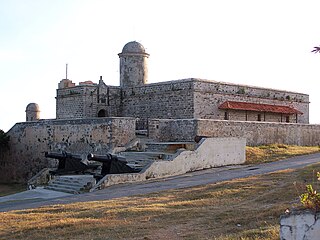 W
WThe Jagua Fortress is a fortress south of Cienfuegos in Cuba. It is located near the entrance to the Cienfuegos Bay, in the port of Jagua. It was originally named "Castillo de Nuestra Señora de los Ángeles de Jagua".
 W
WThe Castillo de la Real Fuerza is a bastion fort on the western side of the harbour in Havana, Cuba, set back from the entrance, and bordering the Plaza de Armas. Originally built to defend against attack by pirates, it suffered from a poor location; it is too far inside the bay. The fort is considered to be the oldest stone fort in the Americas, and was listed in 1982 as part of the UNESCO World Heritage site of "Old Havana and its Fortifications".
 W
WThe Castillo del Príncipe is a military fort located in the Loma de Aróstegui, in Havana, Cuba.
 W
WThe Castillo de Santo Domingo de Atarés is a small hexagonal hilltop fort in Havana built in 1767. Work commenced in 1763, around the same time as initial work on Castillo del Príncipe. It is located on La loma de Soto above the harbour.
 W
WFortaleza de San Carlos de la Cabaña, colloquially known as La Cabaña, is an 18th-century fortress complex, the third-largest in the Americas, located on the elevated eastern side of the harbor entrance in Havana, Cuba. The fort rises above the 200-foot hilltop, along with Morro Castle.
 W
WMorro Castle, named after the three biblical Magi, is a fortress guarding the entrance to Havana bay in Havana, Cuba. The design was drawn up by the Italian engineer Battista Antonelli; originally under the control of Spain, the fortress was captured by the British in 1762, and was returned to the Spanish under treaty terms a year later.
 W
WCastillo San Salvador de la Punta is a fortress at the entrance to the bay in Havana, Cuba.
 W
WThe Santa Clara Battery, with its two remaining coastal guns, one a caliber 305mm (12") Ordóñez HSE Modelo 1892 rifle and the other a 280mm (11") Krupp, stands on the grounds of the Hotel Nacional de Cuba, in Vedado, Havana. UNESCO in 1982 included the battery, together with Old Havana, in its list of UNESCO World Heritage sites. There is a small museum featuring the 1962 Cuban Missile Crisis in the battery. During the crisis, Fidel Castro and Che Guevara set up their headquarters there to prepare the defense of Havana from aerial attack. The museum is in tunnels there known as the Cueva Taganana, for the hill on which the battery stands.
 W
WThe Torreón de la Chorrera, or to give it its full name, Fuerte de Santa Dorotea de la Luna de la Chorrera, was completed in May 1646. The tower stands on a coral islet only a few metres from the shore and not much larger than the tower itself. The tower's purpose was to impede the entry of enemy ships into the mouth of the Almendares River. The British damaged and captured the tower when they took the city in 1762, after which it was rebuilt in its present form. Today, the tower contains a restaurant.